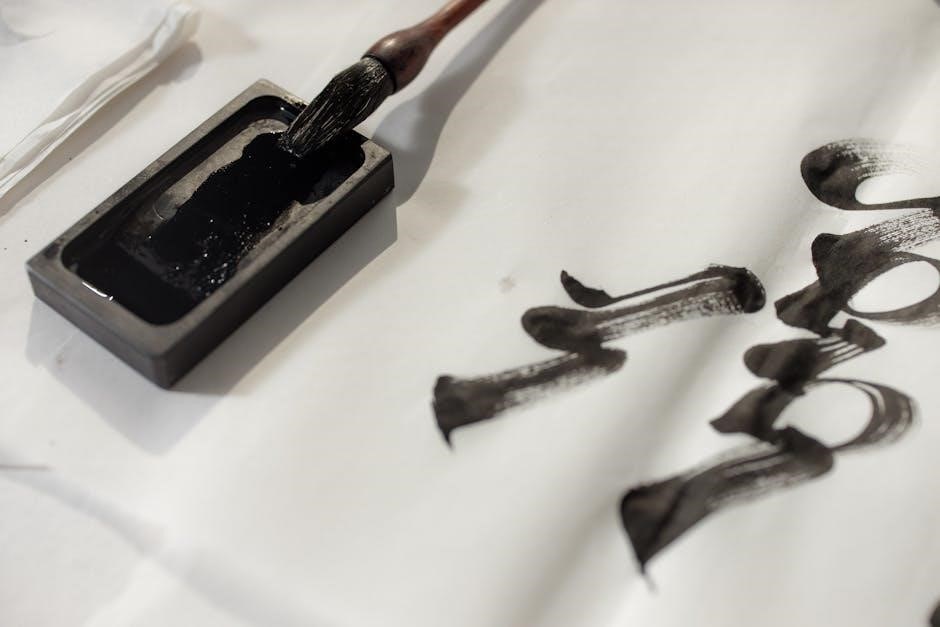Toyota manual transmission fluid plays a crucial role in lubricating gears and protecting internal components from wear and damage. Using the correct fluid ensures smooth operation and longevity.
Understanding the Role of Manual Transmission Fluid in Toyota Vehicles
Manual transmission fluid in Toyota vehicles is essential for lubricating gears, synchronizers, and bearings to ensure smooth shifting and prevent wear. It also helps prevent corrosion and dissipates heat generated by friction. Unlike automatic transmission fluid (ATF), manual transmission fluid is specifically designed for the demands of a manual gearbox. It reduces friction between moving parts, allowing gears to engage smoothly and consistently. Over time, the fluid can degrade, leading to rough shifting or gear noise. Regular maintenance, including fluid checks and changes, is vital to maintain optimal performance and extend the lifespan of the transmission. Proper fluid levels and condition are critical for reliable operation.
Importance of Transmission Fluid in Manual Transmissions
Transmission fluid is vital for lubricating gears, reducing friction, and preventing wear. It ensures smooth shifting and protects internal components from damage caused by heat and friction.
How Transmission Fluid Lubricates Gears and Prevents Damage
Transmission fluid in Toyota manual transmissions plays a critical role in reducing friction between moving gears. It creates a thin, protective layer that prevents metal-to-metal contact, which can cause wear and tear. By lubricating the gears, the fluid ensures smooth shifting and operation. It also helps dissipate heat generated by friction, preventing overheating and potential damage to internal components. Over time, the fluid can degrade, losing its lubricating properties. Using the wrong fluid, such as ATF in a manual transmission, can lead to poor performance or even damage. Regular fluid changes with the correct Toyota-approved or aftermarket fluids, like Redline MT90, are essential to maintain optimal gear performance and extend the transmission’s lifespan.

How to Check Toyota Manual Transmission Fluid Level
Locate the transmission dipstick, often found near the battery. Warm up the engine, pull out the dipstick, and check the fluid level against the markings.
Locating the Transmission Dipstick in Toyota Vehicles
The transmission dipstick in Toyota vehicles is typically located near the battery or on the driver’s side of the engine bay. It may resemble the oil dipstick, so ensure you identify it correctly. In some models, such as sealed transmissions, the dipstick may not be accessible, and fluid checks must be performed at a dealership. Always consult your owner’s manual for specific guidance. If unsure, refer to online resources or contact a Toyota service center for assistance. Proper identification ensures accurate fluid level checks and prevents potential damage from using the wrong dipstick.
Steps to Check the Fluid Level and Condition
To check the Toyota manual transmission fluid, ensure the vehicle is on level ground and the engine is warm. Locate the dipstick near the battery or driver’s side engine bay. Pull out the dipstick and wipe it clean with a lint-free cloth. Reinsert and pull it out again to get an accurate reading. The fluid level should be between the “MIN” and “MAX” marks. Check the color and consistency—clear or amber indicates it’s in good condition, while dark or gritty fluid signals it’s time for a change. If unsure, consult a professional to avoid potential damage. Always refer to the owner’s manual for specific instructions.
Toyota manual transmissions require specific fluids like Redline MT-90 or Toyota-approved gear oils to ensure optimal performance and longevity. These fluids are designed to meet exact viscosity and protection standards. Toyota recommends using GL-4 certified gear oils for manual transmissions, ensuring optimal lubrication and wear protection. The specified viscosity, typically 75W-90, maintains performance across temperature ranges. Always refer to the owner’s manual for exact requirements, as incorrect fluids can damage components. For sealed transmissions, Toyota may require dealer-specific tools and procedures to change fluid. Using genuine or approved aftermarket fluids like Redline MT-90 ensures compliance with Toyota’s standards, maintaining warranty validity and transmission health. Avoid using ATF or GL-5 oils, as they are not compatible with manual transmissions. Proper fluid selection is crucial for smooth gear operation and long-term durability. Aftermarket fluids like Redline MT-90 are widely favored for Toyota manual transmissions due to their exceptional lubrication properties. This 75W-90 synthetic fluid provides superior wear protection and consistent viscosity across temperatures. Its GL-4 certification ensures compatibility with Toyota’s manual transmission requirements. Enthusiasts and technicians often recommend MT-90 for its smooth shifting and durability, especially in high-performance or heavily used vehicles. While more expensive than some options, its quality and performance make it a top choice for maintaining transmission health. Always verify compatibility with your specific Toyota model before use to ensure optimal results and avoid potential damage. MT-90 is a trusted alternative to genuine Toyota fluids, offering excellent value and reliability. To change the fluid, warm up the transmission by driving, then locate the drain plug. Remove it to drain the old fluid into a pan. Refill with the recommended fluid type, ensuring the correct viscosity and specification for your Toyota model. Use a socket to tighten the drain plug securely. Check for leaks and dispose of the used fluid responsibly. Always consult your owner’s manual or a technician if unsure. This process helps maintain smooth gear operation and prevents premature wear. Start by warming up the transmission with a short drive to ensure the fluid drains completely. Locate the transmission drain plug, typically at the bottom of the gearbox. Remove the plug using a socket wrench, allowing the old fluid to drain into a pan. Once fully drained, replace the plug securely. Refill the transmission with the manufacturer-recommended fluid, checking the owner’s manual for correct specifications. Pour slowly to avoid bubbles. Replace the filler plug and start the engine to circulate the new fluid. Check for leaks and test drive to ensure smooth operation. Dispose of the old fluid responsibly. This process maintains optimal transmission performance and longevity. To perform a DIY fluid change, gather essential tools and materials. A socket wrench or ratchet set is needed to remove the drain and filler plugs. A drain pan is crucial for catching the old fluid. New fluid, meeting Toyota’s specifications, ensures compatibility and performance. Funnel helps prevent spills when refilling. Gaskets or seals may be required for the drain plug. Gloves and safety glasses protect during the process. A torque wrench ensures plugs are tightened correctly. Consult the owner’s manual for specific recommendations, as some models may require additional tools. Having everything prepared makes the process efficient and avoids delays. Proper materials ensure a leak-free and effective fluid change. Toyota recommends changing manual transmission fluid every 30,000 to 50,000 miles, depending on usage and model specifications. Look for signs like difficulty shifting gears or unusual noises. Toyota typically recommends changing manual transmission fluid every 30,000 to 50,000 miles, depending on driving conditions and model specifications. For high-mileage vehicles, more frequent changes may be necessary to maintain optimal performance. Always consult the owner’s manual for specific guidance, as intervals can vary. Some sources suggest the fluid can last the lifetime of the transmission under normal conditions, but regular checks are still advised to ensure cleanliness and viscosity. Proper maintenance helps prevent gear wear and ensures smooth shifting. For severe driving conditions or towing, more frequent fluid changes are recommended to prevent overheating and damage. Several indicators suggest it’s time to change the manual transmission fluid in your Toyota. If the fluid appears dirty, cloudy, or has a burnt smell, it’s likely degraded. Low fluid levels, noticeable through the dipstick, can cause gears to overheat and wear. Difficulty shifting gears, grinding noises, or hesitation during acceleration are also signs the fluid needs attention. Additionally, if the transmission slips or jerks, it may indicate insufficient lubrication. Regular inspections can help catch these issues early, preventing costly repairs. Always refer to the owner’s manual for specific guidelines tailored to your vehicle’s model and year. Manual and automatic transmission fluids differ in composition and purpose. Manual fluids are designed for gear lubrication, while automatic fluids manage torque and clutch friction, making them incompatible for use in manual transmissions. Using ATF in a manual transmission can cause severe damage due to its unique chemical properties. ATF is designed for automatic transmissions to manage torque and clutch packs, whereas manual transmissions require fluid that provides specific lubrication without friction modifiers. Mixing ATF with manual transmission fluid can lead to gear damage, clutch failure, and premature wear. Additionally, ATF lacks the necessary viscosity and additives for manual gears, potentially causing overheating and component degradation. Always use Toyota-approved manual transmission fluid to ensure proper lubrication and prevent costly repairs. Using the wrong fluid can void warranties and compromise transmission longevity. The viscosity of manual transmission fluid is critical for proper gear lubrication and performance. Thicker fluids, like GL-4 or GL-5, provide better protection at higher temperatures. The viscosity of manual transmission fluid directly impacts gear performance by ensuring proper lubrication and smooth operation. Thicker fluids, like GL-4 or GL-5, provide better protection at high temperatures but can become too viscous in cold conditions, making shifting harder. Thinner fluids improve cold-weather performance but may lack the protective qualities needed for extreme heat. Balancing viscosity is crucial to prevent wear, overheating, and gear damage. Using the wrong viscosity can lead to increased friction, reduced fuel efficiency, and premature transmission wear. Always refer to Toyota’s specifications to select the optimal fluid for your vehicle’s operating conditions. Proper viscosity ensures longevity and seamless gear engagement. The cost of Toyota manual transmission fluid ranges from $8 to $15 per quart for genuine fluids, with synthetic options priced up to $20. Genuine Toyota manual transmission fluid typically costs between $8 and $15 per quart, depending on the retailer and fluid type. Aftermarket options, such as Redline MT90, may range from $10 to $20 per quart. Synthetic fluids, offering superior performance, are generally priced higher, around $15 to $25 per quart. Budget-friendly alternatives from brands like Valvoline or Castrol are available for $8 to $12 per quart. Prices may vary based on viscosity and formulation, with higher viscosity fluids often costing slightly more. Always consult the owner’s manual or dealership for recommendations to ensure compatibility and optimal performance for your Toyota’s manual transmission. DIY fluid changes are cost-effective for skilled owners, while dealer services ensure precision and warranty compliance, especially for sealed transmissions requiring specialized tools and expertise. DIY transmission fluid maintenance can save money and empower car owners with hands-on experience. It allows for immediate fluid checks and changes, preventing potential damage. However, improper techniques or using the wrong fluid can lead to costly repairs. Additionally, sealed transmissions may require dealer-specific tools, making DIY challenging. Owners must weigh the benefits of convenience and cost against the risks of error. Proper research and adherence to Toyota specifications are essential for successful DIY maintenance. High mileage Toyota vehicles require special attention to their manual transmission fluid. Regular fluid changes and using high-quality oils help maintain performance and prevent wear in older transmissions. Older Toyota models with manual transmissions often require specific fluid types to maintain optimal performance. These vehicles may benefit from high-viscosity oils that provide better lubrication for worn components. Regular fluid changes are crucial as older transmissions are more prone to contamination and heat damage. Additionally, sealed transmissions in older models may need specialized tools or dealership intervention for fluid changes. It’s important to consult the owner’s manual or a Toyota specialist to ensure the correct fluid is used, as improper fluids can lead to premature wear or failure. Proper maintenance can extend the life of older transmissions significantly. Fluid leaks in Toyota manual transmissions often stem from worn gaskets, seals, or loose connections. Early detection is crucial to prevent damage. Regular inspections and using the correct fluid can help minimize risks and ensure long-term reliability. Fluid leaks in Toyota manual transmissions are commonly caused by worn-out gaskets, seals, or loose connections. Over time, these components can degrade, leading to fluid seepage. To address this, inspect the transmission pan gasket, drain plug, and input/output shaft seals for damage. Replace any worn parts with genuine Toyota components to ensure compatibility and reliability. Tightening loose connections or bolts can often resolve minor leaks. For severe cases, consulting a Toyota specialist is recommended to prevent further damage. Regular maintenance and inspections can help identify potential leaks early, ensuring the transmission operates smoothly and efficiently over time. Toyota sealed transmissions are designed to minimize maintenance, with fluid changes typically requiring specialized tools and procedures. This system ensures optimal performance and longevity. Toyota sealed transmissions require specific fluid change procedures, often involving specialized tools and equipment. Fluid changes should typically be performed at a Toyota dealership, as the system is designed to be maintenance-free under normal driving conditions. The fluid is formulated to last the lifetime of the transmission, but extreme driving conditions may necessitate earlier service. Always use Toyota-approved manual transmission fluid to ensure compatibility and optimal performance. Refer to your owner’s manual or consult a certified technician for guidance, as improper fluid changes can lead to system damage. Regular inspections are still recommended to ensure the transmission operates smoothly and efficiently. Fluid temperature is crucial for transmission health. High heat can degrade the fluid, affecting gear performance. Proper tools and monitoring ensure optimal operating conditions and prevent damage. Fluid temperature is critical for transmission health. High heat can degrade the fluid, reducing its lubricating properties and leading to premature gear wear. Maintaining optimal temperatures ensures consistent performance and prevents damage. Monitoring fluid temperature helps identify issues early, avoiding costly repairs. Overheating can cause fluid breakdown, leading to sludge formation and compromised transmission function. Regular checks and proper cooling systems are essential to maintain the fluid’s integrity. Neglecting temperature control can result in accelerated wear and potential transmission failure. Thus, monitoring and managing fluid temperature is vital for long-term reliability and performance of your Toyota’s manual transmission. Proper care of your Toyota’s manual transmission fluid ensures smooth operation and longevity. Regular checks and timely changes maintain performance and prevent damage. Follow Toyota’s recommendations for optimal results. Regularly checking the fluid level and condition ensures optimal performance. Always use Toyota-approved or high-quality aftermarket fluids like Redline MT90. Follow the recommended service intervals, typically every 30,000 to 50,000 miles, depending on usage. Monitor for signs of degradation, such as dark color or burnt odors, and address leaks promptly. Consult your owner’s manual for specific guidance and fluid specifications. Maintaining the correct viscosity ensures smooth gear engagement. Avoid using ATF, as it is designed for automatic transmissions. Proper fluid maintenance extends the life of your manual transmission and prevents costly repairs. Keep track of fluid changes to maintain your vehicle’s health and performance.Types of Fluids Recommended for Toyota Manual Transmissions
Toyota-Approved Manual Transmission Fluid Specifications
Popular Aftermarket Options Like Redline MT90
How to Change Toyota Manual Transmission Fluid
Step-by-Step Guide for a DIY Fluid Change
Tools and Materials Needed for the Process
When to Change Toyota Manual Transmission Fluid
Recommended Service Intervals for Manual Transmissions
Signs Indicating the Need for a Fluid Change

Differences Between Manual and Automatic Transmission Fluids
Why ATF Should Never Be Used in Manual Transmissions

Viscosity of Manual Transmission Fluid
How Viscosity Affects Gear Performance
Cost of Toyota Manual Transmission Fluid
Price Range for Genuine and Aftermarket Fluids

DIY vs. Dealer Service for Fluid Changes
Pros and Cons of DIY Transmission Fluid Maintenance

Manual Transmission Fluid for High Mileage Vehicles
Special Considerations for Older Toyota Models
Manual Transmission Fluid Leaks
Common Causes and Solutions for Fluid Leaks
Toyota Sealed Transmission Systems
Fluid Change Requirements for Sealed Transmissions
Transmission Fluid Temperature Monitoring
Why Fluid Temperature Matters for Transmission Health
Best Practices for Maintaining Toyota Manual Transmission Fluid
